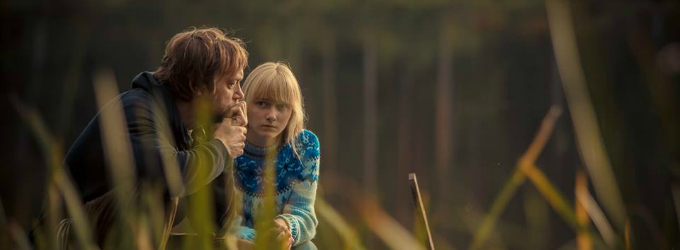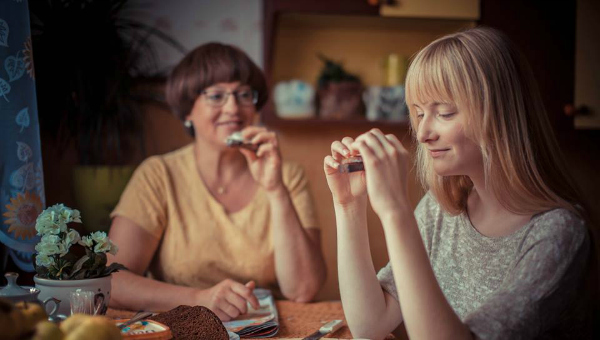
CHERRY TOBACCO tells the story of Laura (Maris Nolvak), an eternally bored teenager beginning her journey into adulthood in a small provincial town in Estonia. Kate Bermingham spoke to co-director Andres Maimik and lead actor Maris Nõlvak ahead of the screening of CHERRY TOBACCO at Cambridge Film Festival this year.
KateBermingham: One of the things I liked about CHERRY TOBACCO was the way in which Laura and Joosep’s relationship was portrayed in a rather innocent, chaste light – was this your intention?
Maris Nõlvak: For me it was clear from the start, when I first read the script, that Laura is that kind of a girl for whom the platonic love is more important. That is why I focused more on the things that were going on in her head and heart, rather than on the things that were seen by the outside world. Laura is more likely to play with the possibilities than wanting anything to happen. It’s that kind of a story – a relationship where nothing happens and therefore everything is possible. When you just know that it is in the air, then you will remain with every possible way to continue the story.
…the movie is about things that could have happened but did not…
Laura and Joosep have the power. They choose to do nothing, they choose the endless possibilities. Therefore, it might seem that the movie is innocent, but actually the movie is about things that could have happened but did not, because the story is controlled by its characters. And Laura is one of those persons for whom it is not necessary to do anything to feel or experience something. Maybe it is just the innocence of a young girl, but maybe it is the maturity of her soul.
Andres Maimik: Naturally it was intentional. After all, the film is about first love. There must be some innocence here. Innocence is essential. We did not want to pay attention to the physical side of passion, but to all of those little shifts in our senses that define the feeling of falling in love. How ordinary things suddenly become significant; how certain places turn into cathedrals; how random objects turn into fetishes. How love can turn water into wine. Our emotional memory and fantasies will be aroused by sensations – smells, tastes, colours – to which a while ago we didn’t assign any meaning.
KB: What is your view on how these relationships – the older man and the young woman – are portrayed in Hollywood cinema?
MN: When I think about it… the Hollywood cinema has done so many different movies and it is hard to do any conclusions, but I would say that I do not think any of the films I have seen that portray the topic have been so “innocent” as you have already said about CHERRY TOBACCO. It is more likely that they have more action in them. In Hollywood cinema they have portrayed many different sides of those kinds of relationships but I have never seen a movie where it had been depicted as it has been in CHERRY TOBACCO.
In CHERRY TOBACCO, it is not about age, it is about two people somehow finding each other in a way that does not have to be put into words — and it never is. Laura and Joosep care for one another. There is nothing physical about it. There is nothing shameful about that. Yes, Laura fell in love, but Joosep also feels something about her, and that is more important than the fact that he is a man – what is more, an older man. He does not want to ruin this sympathy, this strange friendship or understanding they have got with this young, but somehow wise and mature girl.
AM: The relationship between a younger girl and an older guy contains so much social, generational and ethical implications and prejudice already that there was no point in pressing that button. A discreet approach helped us maintain the purity and beauty of this love. Eventually, what took place on screen is just as important in this movie as things that did not happen, but might as well have.
There are wide range of films that depict intimate relationships between an older gentleman and a younger lady, ranging from MY FAIR LADY to LAST TANGO IN PARIS, so I really cannot describe the narrative or aesthetic similarities between these films. I hope that “CHERRY TOBACCO will add a unique nuance to this gallery of interpretations.
“I will never forget how our little crew became like a family…”
KB: CHERRY TOBACCO seems to have been created in quite a simple way. Is this deliberate? To me, it helped to reveal the natural beauty of the Estonian countryside.
AM: Yes, the simplicity of the aesthetics was deliberate. We had one common rule: one scene, one shot – with some exceptions. We prefer to trust the viewer’s eye, instead of dictating what and in which order they have to watch. This is not by any means the easiest way to shoot a film, but it preserves the natural essence of the scene and the scenery.
MN: For me, it was very comfortable to do long takes with no cuts. It helped to create the atmosphere. Also, at some point we became one — the nature and the movie crew. We didn’t have much stuff. We only had one camera. The nature around us made it feel more like a vacation than a job, and as the story itself was warm and beautiful … thanks to that I had a very memorable end of the summer. I will never forget how our little crew became like a family and how we all lived and worked together like one person. We made a new world during the time we were filming in August. I think that this warmth, this breathing as one we had on the set is also captured in the film. That is what I value most about CHERRY TOBACCO. That the material side of the movie is nothing compared to the warmth put there by the people who made it.
CHERRY TOBACCO screens on 29th Aug at 21.15 and 31 Aug at 13.30 at the Cambridge Film Festival.
httpvh://youtu.be/WnZpFLHojwQ

